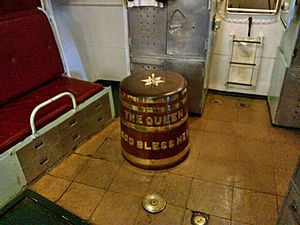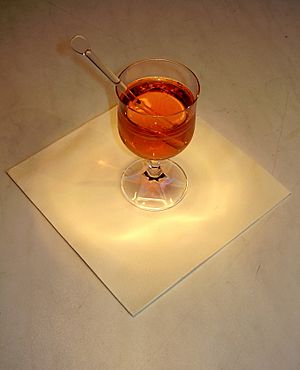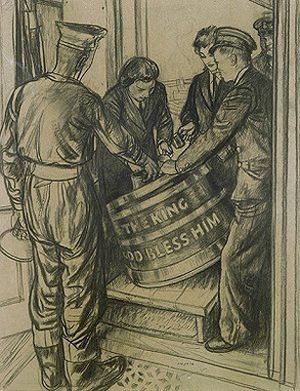Grog facts for kids
Grog is a name for different kinds of alcoholic drinks. The word first meant rum mixed with water. Later, sailors on long sea trips also added limes or lemons to it. This drink was started by British Vice-Admiral Edward Vernon in 1740. He was in charge of a naval group in the West Indies. Vernon wore a coat made of a fabric called grogram, which earned him the nickname Old Grogram or Old Grog.
The word grog was first used in this way around 1770. Today, "grog" has different meanings in various cultures. It is most often used in Australia and New Zealand. There, it is a slang word for any alcoholic drink.
Contents
The Story of Grog
Why Sailors Needed Drinks
In the past (from 1500 to 1800), sailors on long voyages needed a lot of fresh water. It was not possible to clean sea water back then. So, fresh water was carried in large casks. But this water quickly grew algae and became slimy. Stale water was made to taste better by adding beer or wine. This meant carrying even more barrels, and these drinks could also spoil. As trips got longer, storing enough water, beer, or wine for sailors became a big problem.
How Rum Became Popular
After England took over Jamaica in 1655, rum slowly became the main drink for sailors. It replaced beer and brandy. Sailors were given about half a pint of rum each day. But some sailors would save their rum for several days and then drink it all at once. This caused problems with illness and discipline.
To stop this, the rum was mixed with water. This made it less strong and also made it spoil faster. This meant sailors could not save it up. In 1740, British Vice-Admiral Edward Vernon ordered that the daily rum be mixed with four parts water. Half was given out in the morning and the rest after work. This rule became official for the Royal Navy in 1756. It continued until 1970.
Some people thought Vernon added citrus juice to stop the grog from spoiling. They also thought it prevented scurvy. But this is not quite right. Vernon's order said sailors could buy sugar and limes to make the drink taste better. Limes were not needed to fight scurvy for short trips near islands. Scurvy was a problem on very long ocean voyages. Sailors and doctors knew that citrus juice helped scurvy, but they did not know why. Vitamin C was only discovered in 1912. In 1795, the Royal Navy officially added lemon juice and sugar to the sailors' diet. This helped stop scurvy. When lemons were hard to get, West Indian limes were used instead. This is why British sailors became known as limeys.
Where the Name "Grog" Came From
The name "grog" likely came from Admiral Vernon's nickname. He was called "Old Grog" because he wore a cloak made of a coarse fabric called grogram. The term was already being used by 1749, while Vernon was still alive.
How Grog Was Served
On British Ships
Until 1970, Royal Navy rum was very strong (54.6% alcohol). The usual amount was about one-eighth of a pint. It was mixed with two parts water. Sometimes, extra rum was given for special events like Trafalgar Day. Sailors might share their drink with a friend or the cook.
Over time, giving out the rum became a special event. At 11:00 AM, a signal was given. The petty officer of the day would get the keys to the rum storage room. A group of officers and Royal Marines would watch as rum was pumped into a keg. This was one-eighth of a pint for every sailor aged 20 or older who was not being punished. Two marines guarded the keg. Cooks from the different messes would hold out their jugs. A marine sergeant would pour the rum. The rest of the rum was mixed in a tub with two parts water. This became the grog for the regular sailors.
At noon, another signal was given. Cooks from each mess came with tin buckets. The marine sergeant would ladle out the correct number of half-pint servings. Any grog left in the tub was poured into the drains, flowing into the sea.
Petty officers were served first. They could drink their rum without water. Regular sailors often drank their grog quickly after finishing their work around noon.
On American Ships
The practice of serving grog twice a day also happened in the early American navies. Robert Smith, who was the Secretary of the Navy, tried using American rye whiskey instead of rum. Sailors liked it, so he made the change permanent. It is said his sailors called it "Bob Smith" instead of grog.

Unlike Navy sailors, American merchant sailors were not given grog. Ships that did not serve alcohol even got a bonus from their insurance. Sailors on American merchant ships got plenty of hot coffee, but no grog.
The American Navy stopped giving out rum on September 1, 1862. The days of grog slowly ended. In 1850, the amount of grog given was cut in half. Officers stopped getting grog in 1881, and warrant officers in 1918. On January 28, 1970, there was a big discussion in the House of Commons. On July 31, 1970, known as "Black Tot Day", the practice finally ended. Sailors then received an extra can of beer each day instead.
In the early days of British settlement in Australia, the word grog became common. It described watered-down, poor-quality rum. This was often the only alcohol available to working-class people. Eventually, in Australia and New Zealand, "grog" became a slang term for any alcoholic drink. For example, people might say they are going to the "grog shop" to buy grog.
Today, in the United States Navy, U.S. Marine Corps, U.S. Air Force, and U.S. Army, there is a tradition at formal dinners. If someone breaks the rules of etiquette, they are "punished" by being sent to "the grog." They must publicly drink from it. This "grog" is usually a mix of different drinks that do not taste good.
Modern Grog Recipes
There are many different recipes for grog today. The Royal Navy's grog recipe includes water, dark rum, lemon juice, and cinnamon. A common recipe in the Caribbean uses water, light rum, grapefruit juice, orange juice, pineapple juice, cinnamon, and honey.
Grog Today
Modern versions of grog are often made with hot water. They sometimes include lemon juice, lime juice, cinnamon, or sugar for flavor. In the United States, apple cider is sometimes used instead of water. A drink called bumbo was popular with pirates. It was rum with water, sugar, and nutmeg.
In Australia and New Zealand, "grog" means any alcoholic drink. In Cape Verde, grogue is a strong spirit made from sugarcane, similar to rum.
In Sweden, grogg is a common name for drinks made by mixing alcohol with soft drinks or fruit juice. It is not made from a specific recipe. A Swedish grog usually has one type of alcohol (like vodka or brännvin) and one non-alcoholic drink. Some common types are:
- Grosshandlargrogg (meaning "wholesaler grog") is a mix of a strong spirit and a sweet soda called Sockerdricka.
- Musöppnare is made by adding orange juice to brännvin until you cannot taste the alcohol anymore.
- Vargtass (meaning "Wolf's paw") is a mix of brännvin and lingon cordial.
In other parts of Europe, like the Netherlands, Belgium, and France, grog is a hot drink. It is usually made with black tea, lemon juice, honey, and a splash of rum. It is a popular winter drink. People in Belgium and France say it helps with the common cold. In the Netherlands, they say it helps with the flu.
The word groggy (meaning tired or unsteady) also comes from "grog."
See also
 In Spanish: Grog para niños
In Spanish: Grog para niños



